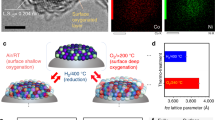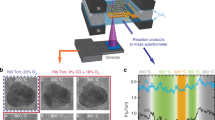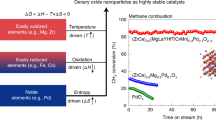Abstract
The selective catalytic oxidation of NH3 to N2 presents a promising solution for the abatement of unused NH3-based reductants from diesel exhaust after treatment. Supported Pd nanoparticle catalysts show selectivity to N2 rather than NOx, which is investigated in this work. The link between Pd nanoparticle structure and surface reactivity was found using operando X-ray absorption fine structure spectroscopy, diffuse reflectance infrared Fourier-transformed spectroscopy and on-line mass spectrometry. Nitrogen insertion into the metallic Pd nanoparticle structure at low temperatures (<200 °C) was found to be responsible for high N2 selectivity, whereas the unfavourable formation of NO is linked to adsorbed nitrates, which form at the surface of bulk PdO nanoparticles at high temperatures (>280 °C). Our work demonstrates the ability of combined operando spectroscopy and density functional theory calculations to characterize a previously unidentified PdNx species, and clarify the selectivity-directing structure of supported Pd catalysts for the selective catalytic oxidation of NH3 to N2.
This is a preview of subscription content, access via your institution
Access options
Access Nature and 54 other Nature Portfolio journals
Get Nature+, our best-value online-access subscription
$29.99 / 30 days
cancel any time
Subscribe to this journal
Receive 12 digital issues and online access to articles
$119.00 per year
only $9.92 per issue
Buy this article
- Purchase on Springer Link
- Instant access to full article PDF
Prices may be subject to local taxes which are calculated during checkout





Similar content being viewed by others
Data availability
The data that support the findings of this study are available from the University of Southampton repository with the identifier https://doi.org/10.5258/SOTON/D0709, or from the authors upon reasonable request.
References
Sobczyk, D. P., Hensen, E. J. M., de Jong, A. M. & van Santen, R. A. Low-temperature ammonia oxidation over Pt/γ-alumina: the influence of the alumina support. Top. Catal. 23, 109–117 (2003).
Weststrate, C. J., Bakker, J. W., Gluhoi, A. C., Ludwig, W. & Nieuwenhuys, B. E. Ammonia oxidation on Ir(1 1 1): why Ir is more selective to N2 than Pt. Catal. Today 154, 46–52 (2010).
Hung, C.-M. Characterization and performance of Pt–Pd–Rh cordierite monolith catalyst for selectivity catalytic oxidation of ammonia. J. Hazard. Mat. 180, 561–565 (2010).
Gang, L., Anderson, B. G., van Grondelle, J. & van Santen, R. A. Low temperature selective oxidation of ammonia to nitrogen on silver-based catalysts. Appl. Catal. B 40, 101–110 (2003).
Burch, R. & Southward, B. W. L. The nature of the active metal surface of catalysts for the clean combustion of biogas containing ammonia. J. Catal. 198, 286–295 (2001).
Carabineiro, S. A. C., Matveev, A. V., Gorodetskii, V. V. & Nieuwenhuys, B. E. Selective oxidation of ammonia over Ru(0 0 0 1). Surf. Sci. 555, 83–93 (2004).
Carabineiro, S. A. C. & Nieuwenhuys, B. E. Selective oxidation of ammonia over Ir(5 1 0). Comparison with Ir(1 1 0). Surf. Sci. 532–535, 87–95 (2003).
Qi, G., Gatt, J. E. & Yang, R. T. Selective catalytic oxidation (SCO) of ammonia to nitrogen over Fe-exchanged zeolites prepared by sublimation of FeCl3. J. Catal. 226, 120–128 (2004).
Qi, G. & Yang, R. T. Selective catalytic oxidation (SCO) of ammonia to nitrogen over Fe/ZSM-5 catalysts. Appl. Catal. A 287, 25–33 (2005).
Long, R. Q. & Yang, R. T. Superior ion-exchanged ZSM-5 catalysts for selective catalytic oxidation of ammonia to nitrogen. Chem. Commun. 0, 1651–1652 (2000).
Gang, L., van Grondelle, J., Anderson, B. G. & van Santen, R. A. Selective low temperature NH3 oxidation to N2 on copper-based catalysts. J. Catal. 186, 100–109 (1999).
Chmielarz, L., Kuśtrowski, P., Rafalska-Łasocha, A. & Dziembaj, R. Selective oxidation of ammonia to nitrogen on transition metal containing mixed metal oxides. Appl. Catal. B 58, 235–244 (2005).
Lee, S. M. & Hong, S. C. Promotional effect of vanadium on the selective catalytic oxidation of NH3 to N2 over Ce/V/TiO2 catalyst. Appl. Catal. B 163, 30–39 (2015).
Il‘chenko, N. I. Catalytic oxidation of ammonia. Russ. Chem. Rev. 45, 1119 (1976).
Chmielarz, L. & Jablonska, M. Advances in selective catalytic oxidation of ammonia to dinitrogen: a review. RSC Adv. 5, 43408–43431 (2015).
Barbier, J. Jr, Oliviero, L., Renard, B. & Duprez, D. Catalytic wet air oxidation of ammonia over M/CeO2 catalysts in the treatment of nitrogen-containing pollutants. Catal. Today 75, 29–34 (2002).
Li, P., Zhang, R., Liu, N. & Royer, S. Efficiency of Cu and Pd substitution in Fe-based perovskites to promote N2 formation during NH3 selective catalytic oxidation (NH3-SCO). Appl. Catal. B 203, 174–188 (2017).
Lousteau, C., Besson, M. & Descorme, C. Catalytic wet air oxidation of ammonia over supported noble metals. Catal. Today 241, 80–85 (2015).
Jabłońska, M. et al. Zeolite Y modified with palladium as effective catalyst for selective catalytic oxidation of ammonia to nitrogen. J. Catal. 316, 36–46 (2014).
Li, Y. & Armor, J. N. Selective NH3 oxidation to N2 in a wet stream. Appl. Catal. B. 13, 131–139 (1997).
Nilsson, J. et al. Chemistry of supported palladium nanoparticles during methane oxidation. ACS Catal. 5, 2481–2489 (2015).
Tew, M. W., Janousch, M., Huthwelker, T. & van Bokhoven, J. A. The roles of carbide and hydride in oxide-supported palladium nanoparticles for alkyne hydrogenation. J. Catal. 283, 45–54 (2011).
Khan, N. A., Shaikhutdinov, S. & Freund, H. J. Acetylene and ethylene hydrogenation on alumina supported Pd–Ag model catalysts. Catal. Lett. 108, 159–164 (2006).
Tew, M. W., Nachtegaal, M., Janousch, M., Huthwelker, T. & van Bokhoven, J. A. The irreversible formation of palladium carbide during hydrogenation of 1-pentyne over silica-supported palladium nanoparticles: in situ Pd K and L3 edge XAS. Phys. Chem. Chem. Phys. 14, 5761–5768 (2012).
Zhang, L., Zhang, C. & He, H. The role of silver species on Ag/Al2O3 catalysts for the selective catalytic oxidation of ammonia to nitrogen. J. Catal. 261, 101–109 (2009).
Bugaev, A. L. et al. In situ formation of hydrides and carbides in palladium catalyst: when XANES is better than EXAFS and XRD. Catal. Today 283, 119–126 (2017).
Lin, C.-M. et al. Size-dependent lattice structure of palladium studied by X-ray absorption spectroscopy. Phys. Rev. B 75, 125426 (2007).
Beale, A. M. & Weckhuysen, B. M. EXAFS as a tool to interrogate the size and shape of mono and bimetallic catalyst nanoparticles. Phys. Chem. Chem. Phys. 12, 5562–5574 (2010).
Soldatov, A. V., Della Longa, S. & Bianconi, A. Relevant role of hydrogen atoms in the XANES of Pd hydride: evidence of hydrogen induced unoccupied states. Solid State Commun. 85, 863–868 (1993).
Ruckman, M. W. et al. XANES study of hydrogen incorporation in a Pd-capped Nb thin film. Phys. Rev. B 57, 3881–3886 (1998).
Tew, M. W., Miller, J. T. & van Bokhoven, J. A. Particle size effect of hydride formation and surface hydrogen adsorption of nanosized palladium catalysts: L3 edge vs K edge X-ray absorption spectroscopy. J. Phys. Chem. C 113, 15140–15147 (2009).
Veith, G. M. et al. Evidence for the formation of nitrogen-rich platinum and palladium nitride nanoparticles. Chem. Mater. 25, 4936–4945 (2013).
Briggs, D. Book Review: Handbook of X-ray spectroscopy. Surf. Interface Anal. 3, 190 (1981).
Rogers, S. M. et al. Tandem site- and size-controlled Pd nanoparticles for the directed hydrogenation of furfural. ACS Catal. 7, 2266–2274 (2017).
Wang, H. & Agmon, N. Complete assignment of the infrared spectrum of the gas-phase protonated ammonia dimer. J. Phys. Chem. A 120, 3117–3135 (2016).
Liu, F. et al. Novel MnWOx catalyst with remarkable performance for low temperature NH3-SCR of NOx. Catal. Sci. Technol. 3, 2699–2707 (2013).
Zhang, L. & He, H. Mechanism of selective catalytic oxidation of ammonia to nitrogen over Ag/Al2O3. J. Catal. 268, 18–25 (2009).
Amores, J. G., Escribano, V. S., Ramis, G. & Busca, G. An FT-IR study of ammonia adsorption and oxidation over anatase-supported metal oxides. Appl. Catal. B 13, 45–58 (1997).
Carré, S., Dujardin, C. & Granger, P. Operando infrared spectroscopy of the reduction of NO by H2 over rhodium based catalysts. Catal. Today 191, 59–64 (2012).
Zhanpeisov, N. U. et al. Interaction of N2O with Ag+ ion-exchanged zeolites: an FT-IR spectroscopy and quantum chemical ab initio and DFT studies. J. Mol. Catal. A 201, 237–246 (2003).
Wcław, A., Nowińska, K., Schwieger, W. & Zielińska, A. N2O decomposition over iron modified zeolites ZSM-5. Catal. Today 90, 21–25 (2004).
Zhang, X., He, H., Gao, H. & Yu, Y. Experimental and theoretical studies of surface nitrate species on Ag/Al2O3 using DRIFTS and DFT. Spectrochim. Acta A 71, 1446–1451 (2008).
Müslehiddinoğlu, J. & Vannice, M. A. Adsorption of NO on promoted Ag/α-Al2O3 catalysts. J. Catal. 217, 442–456 (2003).
Underwood, G. M., Miller, T. M. & Grassian, V. H. Transmission FT-IR and Knudsen cell study of the heterogeneous reactivity of gaseous nitrogen dioxide on mineral oxide particles. J. Phys. Chem. A 103, 6184–6190 (1999).
Caravaggio, G., Nossova, L. & Burich, R. Influence of supports on Pd catalysts for the selective catalytic reduction of NOxwith H2 and CO. Emiss. Control Sci. Technol. 2, 10–19 (2016).
Thompson, P. B. J. et al. X-ray spectroscopy for chemistry in the 2-4 keV energy regime at the XMaS beamline: ionic liquids, Rh and Pd catalysts in gas and liquid environments, and Cl contamination in [gamma]-Al2O3. J. Synchotron. Radiat. 22, 1426–1439 (2015).
Gibson, E. K. et al. Restructuring of AuPd nanoparticles studied by a combined XAFS/DRIFTS approach. Chem. Mater. 27, 3714–3720 (2015).
Dann, E. K. et al. Combined in situ XAFS/DRIFTS studies of the evolution of nanoparticle structures from molecular precursors. Chem. Mater. 29, 7515–7523 (2017).
Marinkovic, N. S. et al. Combined in situ X-ray absorption and diffuse reflectance infrared spectroscopy: an attractive tool for catalytic investigations. Nucl. Instrum. Methods Phys. Res. A 649, 204–206 (2011).
Kresse, G. & Hafner, J. Ab initio molecular dynamics for liquid metals. Phys. Rev. B 47, 558–561 (1993).
Kresse, G. & Hafner, J. Ab initio molecular-dynamics simulation of the liquid-metal–amorphous-semiconductor transition in germanium. Phys. Rev. B 49, 14251–14269 (1994).
Kresse, G. & Furthmüller, J. Efficient iterative schemes for ab initio total-energy calculations using a plane-wave basis set. Phys. Rev. B 54, 11169–11186 (1996).
Blöchl, P. E. Projector augmented-wave method. Phys. Rev. B 50, 17953–17979 (1994).
Kresse, G., Marsman, M. & Furthmuller, J. Vienna ab initio simulation package (VASP) https://cms.mpi.univie.ac.at/vasp/vasp.pdf (2018)
Perdew, J. P., Burke, K. & Ernzerhof, M. Generalized gradient approximation made simple. Phys. Rev. Lett. 77, 3865–3868 (1996).
Makov, G. & Payne, M. Periodic boundary conditions in ab initio calculations. Phys. Rev. B 51, 4014–4022 (1995).
Neugebauer, J. & Scheffler, M. Adsorbate–substrate and adsorbate–adsorbate interactions of Na and K adlayers on Al(111). Phys. Rev. B 46, 16067–16080 (1992).
Grimme, S., Antony, J., Ehrlich, S. & Krieg, H. A consistent and accurate ab initio parametrization of density functional dispersion correction (DFT-D) for the 94 elements H-Pu. J. Chem. Phys. 132, 154104 (2010).
Henkelman, G., Uberuaga, B. P. & Jónsson, H. Climbing image nudged elastic band method for finding saddle points and minimum energy paths. J. Chem. Phys. 113, 9901–9904 (2000).
Henkelman, G. & Jónsson, H. Improved tangent estimate in the nudged elastic band method for finding minimum energy paths and saddle points. J. Chem. Phys. 113, 9978–9985 (2000).
Acknowledgements
We acknowledge UCL and the EPSRC for the iCASE studentship of E.K.D; the beamline scientists at the Swiss Light Source and staff at the Paul Scherrer Institut for the provision of beamtime (proposal 20160396); and the beamline scientists at XMaS, European Synchrotron Radiation Facility, for the provision of beamtime (experiment 28-01-1213). XMaS is a UK national facility supported by EPSRC. We recognize staff at the University of Warwick and University of Liverpool for support in facilitating the beamtime. We also acknowledge the RCaH for the use of facilities, and Johnson Matthey for providing catalyst precursor materials and testing facilities. We thank the UK Catalysis Hub for resources and support provided via our membership of the UK Catalysis Hub Consortium (portfolio grants EP/K014706/1, EP/K014668/1, EP/K014854/1, EP/K014714/1 and EP/I019693/1). Via our membership of the UK’s HEC Materials Chemistry Consortium, which is funded by the EPSRC (EP/L000202), this work used the ARCHER UK National Supercomputing service (http://www.archer.ac.uk). We acknowledge the use of Athena at HPC Midlands+, which was funded by the EPSRC (grant EP/P020232/1), in this research, via the EPSRC RAP call of spring 2018. We also thank HPC Wales for the computing time.
Author information
Authors and Affiliations
Contributions
The experiments on SuperXAS were performed by P.P.W., E.K.D., E.K.G., R.H.B., M.N. and A.G. The experiments on XMaS at the European Synchrotron Radiation Facility were performed by P.P.W., E.K.D., G.F.T., P.T. and S.M.R. The catalysts were prepared by E.K.D. and A.R., with routine characterization performed by E.K.D. The X-ray absorption spectroscopy data were interpreted by P.P.W., E.K.D., A.K. and E.K.G. XPS measurements were performed and analysed by E.K.D., S.F.R.T. and T.E.E. The computational work was performed by A.C. and C.D.Z.-Y. The work was conceived and designed by P.P.W., C.R.A.C., A.G., P.C. and C.H. The manuscript was written by P.P.W., E.K.D., A.C. and A.G.
Corresponding authors
Ethics declarations
Competing interests
The authors declare no competing interests.
Additional information
Publisher’s note: Springer Nature remains neutral with regard to jurisdictional claims in published maps and institutional affiliations.
Supplementary information
Supplementary Information
Supplementary Figures 1–22; Supplementary Tables 1–10; Supplementary Note 1
Rights and permissions
About this article
Cite this article
Dann, E.K., Gibson, E.K., Blackmore, R.H. et al. Structural selectivity of supported Pd nanoparticles for catalytic NH3 oxidation resolved using combined operando spectroscopy. Nat Catal 2, 157–163 (2019). https://doi.org/10.1038/s41929-018-0213-3
Received:
Accepted:
Published:
Issue Date:
DOI: https://doi.org/10.1038/s41929-018-0213-3
This article is cited by
-
Technological solutions for NOx, SOx, and VOC abatement: recent breakthroughs and future directions
Environmental Science and Pollution Research (2023)
-
Harnessing strong metal–support interactions via a reverse route
Nature Communications (2020)



